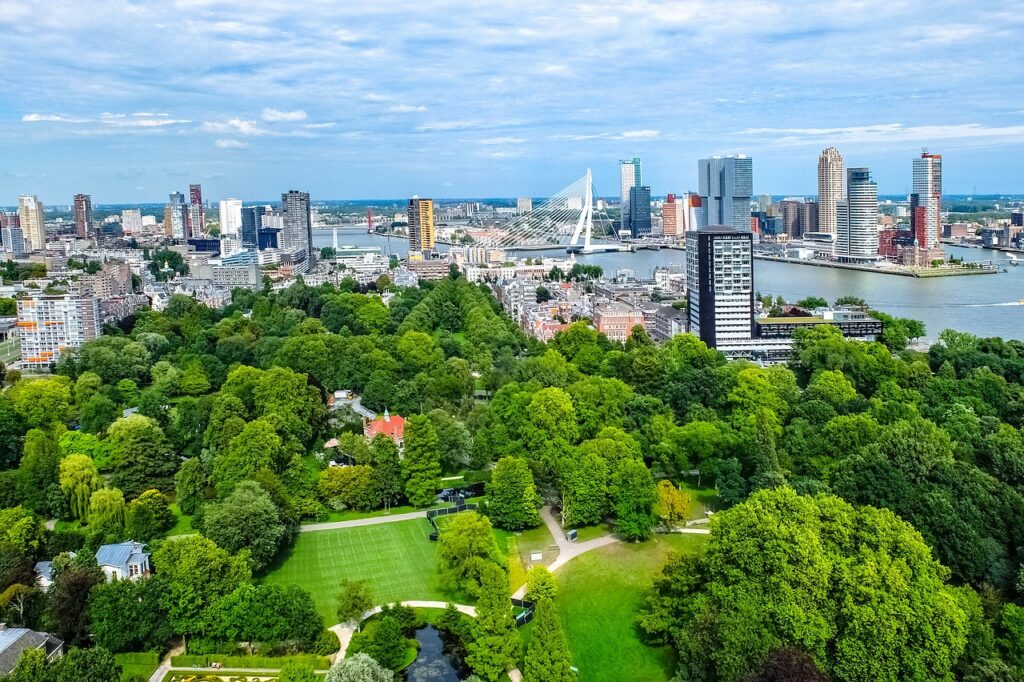You live in the city. The sun peeks through your window, and as May rolls around the corner, you eagerly put away your winter coats, preparing for the warm summers. Yet when summer approaches, your commute leads you out of breath as the sun boils your skin. Sitting outside has become more uncomfortable than enjoyable, and you turn to your friends and say, “It’s so hot this summer; I don’t remember it being like this last year”. Your friend shrugs and responds with, “Climate change, I guess”. It’s a phenomenon we don’t think much about, and sure, we can ultimately blame climate change for the increasingly warm summer. However, this increase in heat is more specifically known as the Urban Heat Island effect.

What is the Urban Heat Island Effect?
Cities tend to accumulate heat more than rural areas. Due to an increase in human activities and a dense number of surfaces that retain and absorb heat, such as pavement and buildings, heat becomes trapped within the area, creating the phenomenon known as the Urban Heat Island Effect (UHI). This effect leads to various negative consequences, affecting both the environment and human health. However, with more research, cities are now trying to implement ways to mitigate UHI with methods such as green roof construction and land cultivation, energy efficiency improvements, and urban landscape optimization, which may finally lead to a decrease in long, severe heat waves.
Negative Consequences to Urban Heat Island
The impacts of increased weather may not seem severe, but the Urban Heat Island Effect (UHI) brings many negative consequences, including increased energy consumption, higher greenhouse gas emissions, and health risks.
As summer temperatures rise, more people rely on air conditioning to stay cool. Studies analyzing electricity demand during peak warm months find that for each degree the temperature increases, electricity consumption rises between 0.45% to 4.6%. Moreover, extreme heat events can cause an overloading demand for air conditioning, leading to brownouts or blackouts in cities.
With increased energy consumption, buildings require more energy, often relying on fossil fuels to meet this demand. This leads to air pollutants and greenhouse gas emissions. The concern is that with more fossil fuel power plants, carbon dioxide emissions increase, contributing to global climate change. Fossil fuel emissions can also negatively impact human health by impairing air quality, leading to issues like smog or acid rain.
Many people become vulnerable to increased temperatures during UHI events, suffering from discomfort, respiratory difficulties, heat strokes, or heat exhaustion. The UHI effect often exacerbates heat waves, affecting vulnerable populations, including older adults, young children, and low-income communities. These groups may lack resources to cope with high temperatures, such as inadequate housing or no air conditioning. Workers in outdoor conditions or people with preexisting health issues are also at greater risk. The Centers for Disease Control and Prevention found that between 2014 and 2018, an average of 702 deaths occurred annually due to heat-related causes.
These are just a few impacts of UHI that significantly affect human and environmental health. Understanding these impacts and gathering further research can help researchers find ways to mitigate the effects and reduce heat levels in urban environments.
Possible Solutions
What are some methods or techniques that cities can implement to mitigate the Urban Heat Island (UHI) effect? Some solutions may include increasing greenery, installing green roofs, and enhancing surface reflectivity.
Greenery
Adding greenery to urban areas not only helps mitigate air pollution but can also be effective in cooling urban spaces. The primary solution that vegetation provides is shading, which blocks solar radiation from reaching the surface, thereby providing a cooling effect. Additionally, increasing urban vegetation brings many other social, economic, and environmental benefits. Many cities are already implementing this approach through green roofs, vegetated facades, and urban parks.
Surface Reflectivity
Urban materials such as pavement and buildings tend to be dark in colour, leading to increased heat absorption. Using cooling materials can decrease heat absorption and create a natural cooling process, allowing solar energy to be released from the urban environment instead of being stored. This can be achieved through the use of highly reflective materials that reflect short-wave radiation back into the atmosphere. However, there are some drawbacks to this method, as reflective materials in urban spaces can reflect solar energy into nearby buildings or onto people, potentially causing discomfort or damage. Maintenance is also required to ensure the effectiveness of these materials.
As temperatures are expected to rise in the coming years, the Urban Heat Island (UHI) effect is likely to worsen. Many urban areas are already implementing different techniques, such as installing green roofs and adding reflective surfaces, to reduce heat absorption. This summer, as temperatures increase or severe heat waves occur, remember to stay hydrated, stay cool, and spread awareness to your friends about the growing phenomenon of the Urban Heat Island effect and its impact on our cities.
References
Environmental Protection Agency. (2023, August 28). Heat Island Impacts. EPA.https://www.epa.gov/heatislands/heat-island-impacts#:~:text=Heat%20islands%20contribute%20to%20higher,and%20non%2Dfatal%20heat%20stroke.
Santamouris, M. 2020. Recent progress on urban overheating and heat island research. Integrated assessment of the energy, environmental, vulnerability and health impact. Synergies with the global climate change. Energy and Buildings 207:109482.
Vaidyanathan. A., J. Malilay, P. Schramm, and S. Saha. 2020. Heat-related deaths — United States, 2004–2018. Morbidity and Mortality Weekly Report 69(24):729–734.
Yang, Li & Qian, Feng & Song, De-Xuan & Zheng, Ke-Jia. (2016). Research on Urban Heat-Island Effect. Procedia Engineering. 169. 11-18. 10.1016/j.proeng.2016.10.002.





